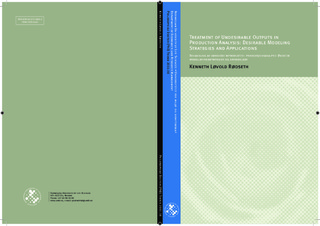| dc.contributor.advisor | Romstad, Eirik | |
| dc.contributor.author | Rødseth, Kenneth Løvold | |
| dc.date.accessioned | 2017-03-15T11:43:42Z | |
| dc.date.available | 2017-03-15T11:43:42Z | |
| dc.date.issued | 2011 | |
| dc.identifier.isbn | 978-82-575-1001-5 | |
| dc.identifier.issn | 1503-1667 | |
| dc.identifier.uri | http://hdl.handle.net/11250/2434180 | |
| dc.description.abstract | The thesis consists of an introduction and four related papers. Their common topic is production analysis when undesirable outputs are accounted for. The introduction establishes the research platform on which the following papers are built by reviewing existing literature, proposing a new way of modeling environmentally regulated firms, and introducing some new areas of model application.
The first article evaluates one of the most commonly applied axioms when some outputs are undesirable, namely weak disposability. The axiom is discussed in relation to the materials balance condition. It is shown that the two cannot hold simultaneously except when introducing abatement activities. Second, since abatement is not explicitly accounted for when applying the weak disposability axiom, the potential for reducing emissions may be overstated. This has important implications for efficiency measurement and estimation of marginal abatement costs.
The second article builds on the conclusions from the first article by explicitly accounting for both the ways undesirable outputs are generated and how they may be reduced. Profit maximization under environmental regulation is evaluated and it is shown how regulations increase the costs of polluting inputs and lead to forgone profits. Consequently, allocative efficiency may be underestimated if regulatory constraints are not accounted for. Using U.S. electricity data, I find empirical support for this proposal. This is contrary to the established literature that has mainly focused on undesirable outputs’ influence on technical efficiency.
The third article’s purpose is to extend an established method for abatement cost estimation to account for more flexible producer responses to environmental regulation than is currently being done. By applying the directional distance function, marginal abatement costs are derived that reflect the least cost way of reducing undesirable outputs.
The fourth article develops one of the new areas of model application proposed in the introduction, namely evaluating how efforts directed at reducing some undesirable output may influence other undesirable outputs due to jointness. The emphasis is on how different strategies for reducing undesirable outputs influence the occurrence of reductions in secondary undesirable outputs. | nb_NO |
| dc.language.iso | eng | nb_NO |
| dc.publisher | Norwegian University of Life Sciences, Ås | nb_NO |
| dc.relation.ispartofseries | PhD Thesis;2011:38 | |
| dc.rights | Attribution-NonCommercial-NoDerivatives 4.0 Internasjonal | * |
| dc.rights.uri | http://creativecommons.org/licenses/by-nc-nd/4.0/deed.no | * |
| dc.title | Treatment of undesirable outputs in production analysis : desirable modeling strategies and applications | nb_NO |
| dc.title.alternative | Behandling av uønskede biprodukter i produksjonsanalyse : ønskede modelleringsstrategier og anvendelser | nb_NO |
| dc.type | Doctoral thesis | nb_NO |
| dc.subject.nsi | VDP::Social science: 200::Economics: 210::Economics: 212 | nb_NO |
| dc.source.pagenumber | 93 | nb_NO |

